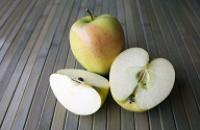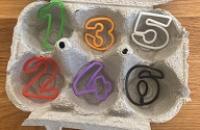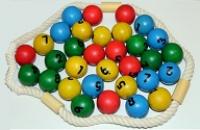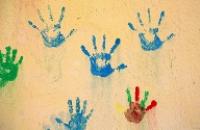Counting reliably
Understanding numerals and solving problems





Children often enjoy activities which involve counting and packing, as well as helping those who are less experienced than themselves.
Adults could include a range of numbers and make selected mistakes to see if children can demonstrate and explain solutions.
The Activity
This is a problem-solving story for an adult with a large or small group of children. Owl has a pictorial packing list with the numbers of various things he needs to take away with him on a visit to his aunty for a few days. He has got lots of all the things, but he needs help reading the numbers on his list and counting the right amounts into his travel bag. He keeps making mistakes which he needs help to sort out.
Encouraging mathematical thinking and reasoning:
Describing
How many things can you see?
Roughly how many do you think there are?
Reasoning
How does Owl know how many this means?
How does Owl know he has the right number? Can you find another way to check?
Opening Out
What can he do if gets the wrong number? Not enough? Too many?
Suppose he stays for twice as long? Or he takes a friend or a pet?
Recording
How do you know how many this (numeral) means?
Is there a different way we could show Owl how many things to pack?
Can you make a packing list for someone for a trip for a number of days, to show them how many things they will need?
The Mathematical Journey
Counting and cardinality:
- remembering the word-number sequence
- saying one number for each object
- understanding cardinality i.e. that the 'stopping number' gives the right amount when counting out a number from a larger group
- counting in a different order to check
Knowing number values:
- making reasonable estimates
- subitising or knowing how many there are without counting e.g. recognising a dice pattern
Matching numerals and amounts:
- using a number line independently to find a numeral illustrated with a number of things
- reading numerals with the purpose of seeing how many things there should be
Development and Variation
Relate to a calendar and days of the week.
Trips can be for more days, or with more creatures.
Other toys could be used with other requirements e.g. T-shirts and socks for a doll, dog food/rabbit pellets for a pet dog/rabbit...
Children could:
- have packing lists in pairs
- make up their own packing lists
- buy things in a class shop for packing
Resources

- A very large pictorial packing list - you could have just the numeral and a picture of the item, or words as well.
- Collections of all the things Owl will need for his trip, e.g. tickets, spare feathers, miniature shampoo bottles, biscuits and apples, reading books, toys/stuffed animals, stationery/pens, spending money, presents to give his aunty...
- A travel bag.
- A large number line, with easily recognised patterns of things (e.g. dot patterns) to show the meaning of the symbols and to help children decode these independently.
- A calendar.
Download a PDF of this resource.
With thanks to Nicola Papastavrou-Brooks for the image

